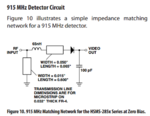BiNa2605
Full Member level 3
I simulated the UHF antenna in HFSS, expected resonant freq. is 915MHz. The results shows very promising (S11~-35dB). But when I make a PCB, the figure below, the result is implemented by using Network Analyzer, the resonant freq. shifted from 915MHz to ~1.9GHz.
In the simulation file, I chosed FR4 as a material, is it right?. Does anyone get me some recommendations for that? What could I can change for achieving a good result?
-Applying matching circuit.
-Make a new one. How can I calculate exactly?
Thanks



- - - Updated - - -
This is the HFSS project file.
In the simulation file, I chosed FR4 as a material, is it right?. Does anyone get me some recommendations for that? What could I can change for achieving a good result?
-Applying matching circuit.
-Make a new one. How can I calculate exactly?
Thanks



- - - Updated - - -
This is the HFSS project file.






